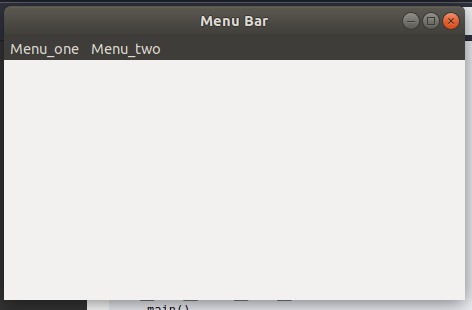在本文中,我们将学习wx.MenuBar类的Remove()函数。 Remove()函数从菜单栏中菜单栏中的特定位置删除菜单。此函数采用pos参数,即要删除的菜单位置。
参数:
| 参数 | 输入类型 | 描述 |
|---|---|---|
| pos | int | 新菜单在菜单栏中的位置 |
码:
让我们在菜单栏中创建一个带有两个菜单的窗口Menu_one和Menu_two。
Python3
import wx
class Example(wx.Frame):
def __init__(self, *args, **kw):
super(Example, self).__init__(*args, **kw)
# create MenuBar using MenuBar() function
menubar = wx.MenuBar()
# add menu to MenuBar
fm1 = wx.Menu()
fileitem = fm1.Append(20, "one")
fm2 = wx.Menu()
fileitem2 = fm2.Append(20, "two")
menubar.Append(fm1, '&Menu_one')
menubar.Append(fm2, '&Menu_two')
self.SetMenuBar(menubar)
self.SetSize((300, 200))
self.SetTitle('Menu Bar')
def main():
app = wx.App()
ex = Example(None)
ex.Show()
app.MainLoop()
if __name__ == '__main__':
main()
输出:

码:
让我们写一个代码从菜单栏中删除Menu_two。
Python3
import wx
class Example(wx.Frame):
def __init__(self, *args, **kw):
super(Example, self).__init__(*args, **kw)
# create MenuBar using MenuBar() function
menubar = wx.MenuBar()
# add menu to MenuBar
fm1 = wx.Menu()
fileitem = fm1.Append(20, "one")
fm2 = wx.Menu()
fileitem2 = fm2.Append(20, "two")
menubar.Append(fm1, '&Menu_one')
menubar.Append(fm2, '&Menu_two')
self.SetMenuBar(menubar)
self.SetSize((300, 200))
self.SetTitle('Menu Bar')
# removing Menu_two from menubar
menubar.Remove(1)
def main():
app = wx.App()
ex = Example(None)
ex.Show()
app.MainLoop()
if __name__ == '__main__':
main()输出:

相关用法
- wxPython wx.MenuBar SetLabel()用法及代码示例
- wxPython wx.MenuBar GetHelpString()用法及代码示例
- wxPython wx.MenuBar SetHelpString()用法及代码示例
- wxPython wx.MenuBar FindMenuItem()用法及代码示例
- wxPython wx.MenuBar GetMenuLabelText()用法及代码示例
- wxPython wx.MenuBar GetMenuLabel()用法及代码示例
- wxPython wx.MenuBar GetMeuCount()用法及代码示例
注:本文由纯净天空筛选整理自RahulSabharwal大神的英文原创作品 wxPython – Remove() function in wx.MenuBar。非经特殊声明,原始代码版权归原作者所有,本译文未经允许或授权,请勿转载或复制。
